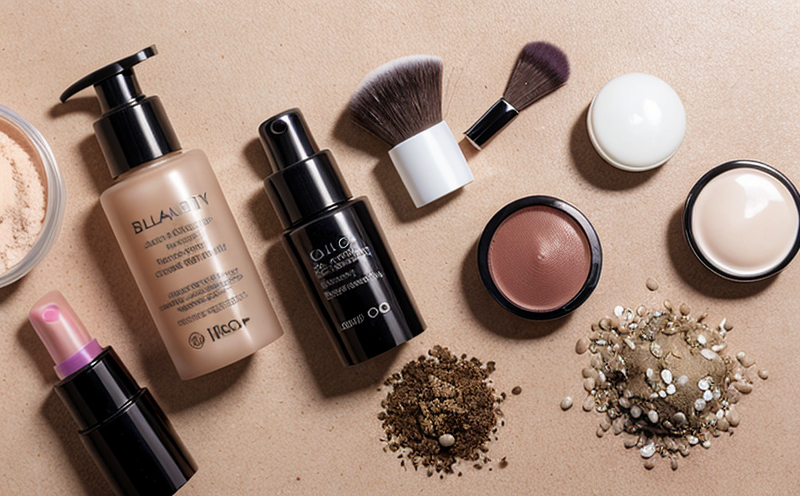Aquatic Bioassay Testing of Cosmetic Ingredients
The aquatic bioassay testing of cosmetic ingredients is a critical component in ensuring that beauty products are both safe and sustainable. This method involves exposing aquatic organisms to various cosmetic ingredients under controlled conditions to assess their potential impact on the environment. The test parameters, specimen preparation, instrumentation used, and reporting methods are meticulously designed to provide accurate and reliable data.
In this testing process, the focus is primarily on the biodegradability of cosmetic ingredients. Biodegradability refers to the ability of a substance to break down into harmless substances through biological action. This is particularly important for ingredients that end up in waterways as runoff from waste products or during use. The aquatic bioassay test helps determine if these ingredients will harm aquatic life, such as fish, algae, and other microorganisms.
The testing process typically involves exposing the organisms to different concentrations of cosmetic ingredients over a specified period. This allows scientists to observe any negative effects on the health and survival rates of the organisms. The results are then compared against control groups that do not receive exposure to these ingredients. Compliance with international standards such as ISO 16005, ASTM E2487, and EN 301 859 ensures consistency and reliability across different laboratories.
The equipment used in aquatic bioassay testing includes specialized tanks designed for maintaining specific environmental conditions like temperature, pH levels, and salinity. High-quality water filtration systems ensure that the test environment remains stable throughout the duration of the experiment. Additionally, automated monitoring systems are often employed to continuously measure key parameters like dissolved oxygen levels and nutrient concentrations.
Preparing the specimens correctly is crucial for accurate results. Samples must be thoroughly mixed with deionized water before being dispensed into the test chambers according to predefined protocols. Special care should also be taken during handling to avoid contamination from external sources which could skew experimental outcomes.
The interpretation of results requires careful analysis by experienced professionals who understand both chemistry and biology aspects involved in this field. They look for signs such as reduced mobility, increased mortality rates among exposed groups compared to controls, changes in feeding behavior, etc., indicating adverse effects on aquatic ecosystems.
Understanding the importance of biodegradability helps manufacturers choose sustainable alternatives that minimize environmental impact while maintaining product efficacy. By integrating such tests into their R&D processes early on, companies can make informed decisions about ingredient selection and formulation adjustments aimed at reducing overall ecological footprint associated with cosmetic products.
Why It Matters
The significance of aquatic bioassay testing cannot be overstated when it comes to protecting our natural resources. As global population growth continues, so does the demand for cosmetics and personal care items. However, improper disposal or runoff from these products can lead to pollution in water bodies which affects not only wildlife but also human health indirectly.
Biodegradability tests like this one play a vital role in ensuring that new formulations meet stringent environmental regulations set forth by governmental bodies worldwide. For instance, Europe's REACH regulation requires manufacturers to demonstrate the biodegradation properties of all novel chemicals before they can be marketed within EU member states. Similarly, China has been implementing stricter requirements regarding the lifecycle assessment (LCA) and end-of-life treatment plans for various consumer goods including cosmetics.
Conducting these tests early in the development cycle allows companies to identify potential issues upfront rather than discovering them later during product launches when changes become more challenging and costly. Early intervention also promotes innovation by encouraging research into greener alternatives which could enhance brand reputation among eco-conscious consumers.
Customer Impact and Satisfaction
Aquatic bioassay testing directly contributes to enhancing customer trust in brands committed to sustainability practices. When customers know that their favorite products undergo rigorous environmental assessments, they feel reassured about the safety and ethical sourcing of these items. This fosters loyalty towards brands who prioritize both quality and responsible business operations.
From a regulatory standpoint, meeting biodegradability requirements demonstrates compliance with international standards such as ISO 16005 or ASTM E2487. These certifications add value to products by signaling adherence to high-quality manufacturing processes. Consumers often view these badges favorably when making purchasing decisions, leading to increased sales and market share.
Moreover, engaging in sustainable practices can attract new customers who are increasingly concerned about environmental impact. Companies that demonstrate leadership in this area tend to see higher brand awareness and stronger online presence through social media campaigns highlighting their efforts towards greener initiatives.
International Acceptance and Recognition
The acceptance of aquatic bioassay testing for cosmetic ingredients has gained significant traction globally. Regulatory bodies across different countries have recognized the importance of incorporating such assessments into product development cycles to ensure environmental safety.
In Europe, REACH (Registration, Evaluation, Authorization and Restriction of Chemicals) legislation mandates that all new chemical substances must pass biodegradation tests before being placed on the market. This regulation applies not only to traditional chemicals but also extends its scope to include cosmetic ingredients since many of them contain synthetic compounds.
Similarly, in North America, the Environmental Protection Agency (EPA) has established guidelines encouraging companies to consider life cycle impacts when designing innovative products like cosmetics. By adopting biodegradability testing early on during R&D phases, manufacturers can align themselves with these regulatory expectations and gain competitive advantages over competitors who may lag behind.
Asian markets such as China have also started implementing similar measures aimed at reducing harmful effects caused by improper disposal of waste materials from cosmetic products. The Chinese government has launched initiatives promoting circular economy principles within industries including cosmetics, encouraging companies to adopt sustainable practices throughout their supply chains.





